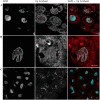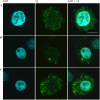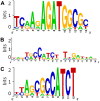Nuclear translocation of vitellogenin in the honey bee (Apis mellifera)
- PMID: 35309709
- PMCID: PMC8924143
- DOI: 10.1007/s13592-022-00914-9
Nuclear translocation of vitellogenin in the honey bee (Apis mellifera)
Abstract
Vitellogenin (Vg) is a conserved protein used by nearly all oviparous animals to produce eggs. It is also pleiotropic and performs functions in oxidative stress resistance, immunity, and, in honey bees, behavioral development of the worker caste. It has remained enigmatic how Vg affects multiple traits. Here, we asked whether Vg enters the nucleus and acts via DNA-binding. We used cell fractionation, immunohistology, and cell culture to show that a structural subunit of honey bee Vg translocates into cell nuclei. We then demonstrated Vg-DNA binding theoretically and empirically with prediction software and chromatin immunoprecipitation with sequencing (ChIP-seq), finding binding sites at genes influencing immunity and behavior. Finally, we investigated the immunological and enzymatic conditions affecting Vg cleavage and nuclear translocation and constructed a 3D structural model. Our data are the first to show Vg in the nucleus and suggest a new fundamental regulatory role for this ubiquitous protein.
Supplementary information: The online version contains supplementary material available at 10.1007/s13592-022-00914-9.
Keywords: DNA binding; Vitellogenin; nuclear protein.
© The Author(s) 2022.
Conflict of interest statement
Conflict of interestThe authors declare no competing interests.
Figures






Similar articles
-
Ancient Duplications Have Led to Functional Divergence of Vitellogenin-Like Genes Potentially Involved in Inflammation and Oxidative Stress in Honey Bees.Genome Biol Evol. 2016 Mar 9;8(3):495-506. doi: 10.1093/gbe/evw014. Genome Biol Evol. 2016. PMID: 26961250 Free PMC article.
-
Structure prediction of honey bee vitellogenin: a multi-domain protein important for insect immunity.FEBS Open Bio. 2022 Jan;12(1):51-70. doi: 10.1002/2211-5463.13316. Epub 2021 Oct 31. FEBS Open Bio. 2022. PMID: 34665931 Free PMC article.
-
How Honey Bee Vitellogenin Holds Lipid Cargo: A Role for the C-Terminal.Front Mol Biosci. 2022 Jun 9;9:865194. doi: 10.3389/fmolb.2022.865194. eCollection 2022. Front Mol Biosci. 2022. PMID: 35755821 Free PMC article.
-
Resolving the zinc binding capacity of honey bee vitellogenin and locating its putative binding sites.Insect Mol Biol. 2022 Dec;31(6):810-820. doi: 10.1111/imb.12807. Epub 2022 Aug 23. Insect Mol Biol. 2022. PMID: 36054587 Free PMC article.
-
Cytosine modifications in the honey bee (Apis mellifera) worker genome.Front Genet. 2015 Feb 6;6:8. doi: 10.3389/fgene.2015.00008. eCollection 2015. Front Genet. 2015. PMID: 25705215 Free PMC article. Review.
Cited by
-
Bixafen, Prothioconazole, and Trifloxystrobin Alone or in Combination Have a Greater Effect on Health Related Gene Expression in Honey Bees from Nutritionally Deprived than from Protein Supplemented Colonies.Insects. 2024 Jul 11;15(7):523. doi: 10.3390/insects15070523. Insects. 2024. PMID: 39057256 Free PMC article.
-
Changes in gut microbiota and metabolism associated with phenotypic plasticity in the honey bee Apis mellifera.Front Microbiol. 2022 Dec 9;13:1059001. doi: 10.3389/fmicb.2022.1059001. eCollection 2022. Front Microbiol. 2022. PMID: 36569094 Free PMC article.
-
Changes in Vitellogenin (Vg) and Stress Protein (HSP 70) in Honey Bee (Apis mellifera anatoliaca) Groups under Different Diets Linked with Physico-Chemical, Antioxidant and Fatty and Amino Acid Profiles.Insects. 2022 Oct 26;13(11):985. doi: 10.3390/insects13110985. Insects. 2022. PMID: 36354809 Free PMC article.
-
Morphological and histochemical characteristics of the foregut, midgut, and hindgut, and their alterations during ovarian development in female freshwater prawn, Macrobrachium rosenbergii.Cell Tissue Res. 2025 Mar;399(3):351-375. doi: 10.1007/s00441-024-03948-w. Epub 2025 Jan 13. Cell Tissue Res. 2025. PMID: 39800825 Free PMC article.
-
Transcriptional signature of host shift in the seed beetle Zabrotes subfasciatus.Genet Mol Biol. 2024 Feb 5;47(1):e20230148. doi: 10.1590/1678-4685-GMB-2023-0148. eCollection 2024. Genet Mol Biol. 2024. PMID: 38314880 Free PMC article.
References
-
- Andrews, S. (2010) FastQC A Quality Control tool for High Throughput Sequence Data. https://www.bioinformatics.babraham.ac.uk/projects/fastqc/ (accessed 10.12.18).
-
- Aronesty, E. (2011) ea-utils: Command-line tools for processing biological sequencing data.
LinkOut - more resources
Full Text Sources
